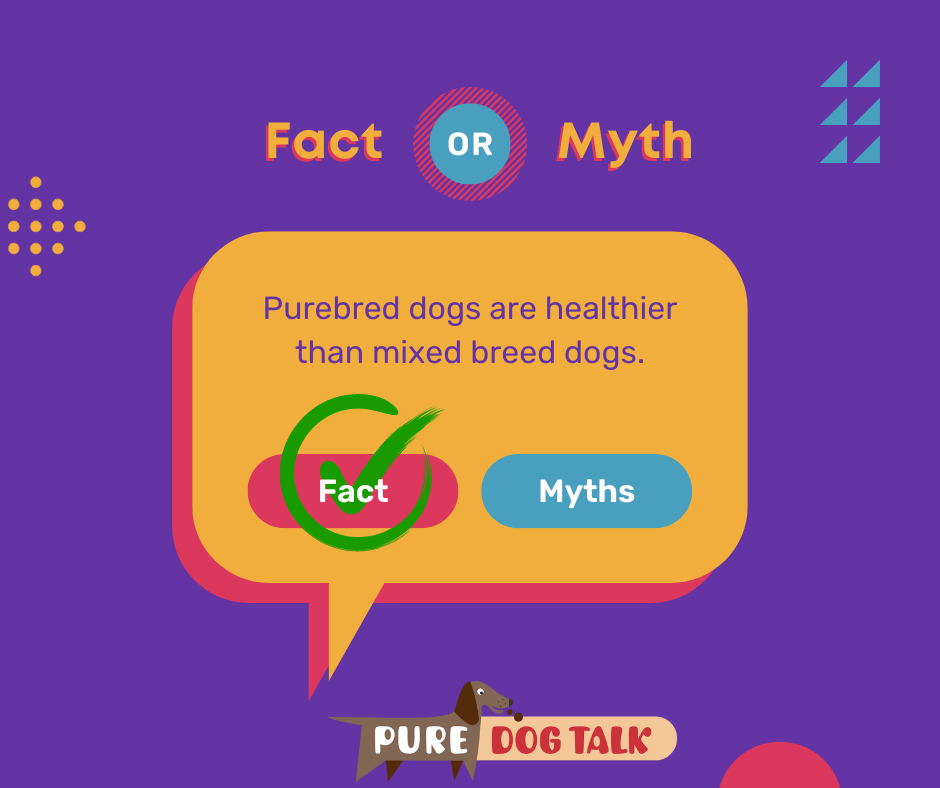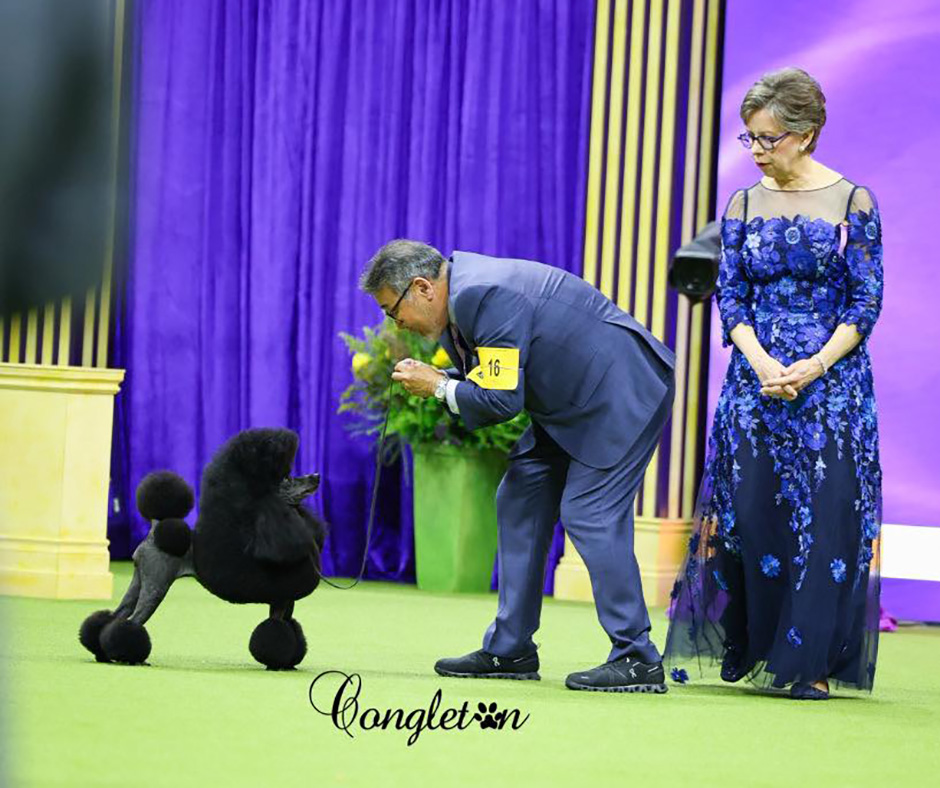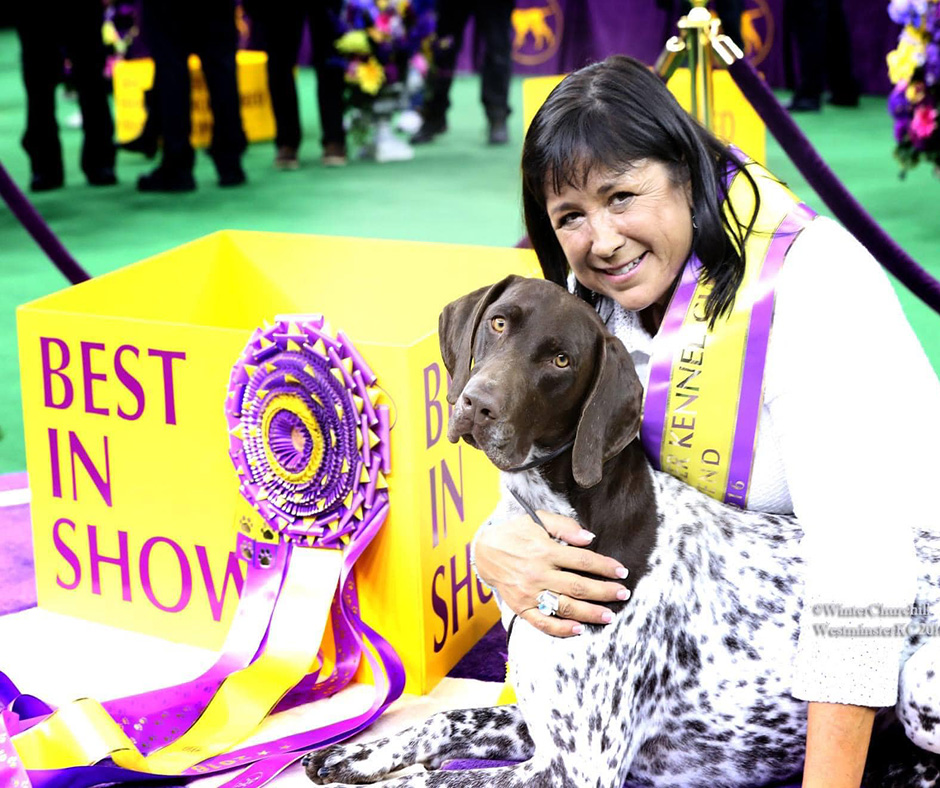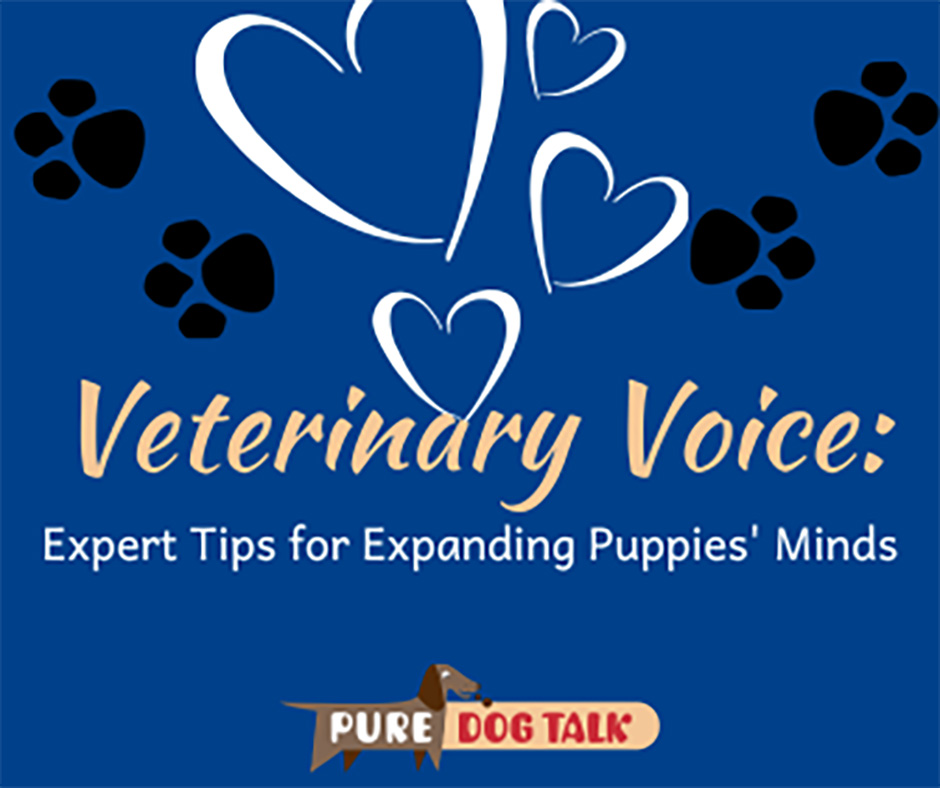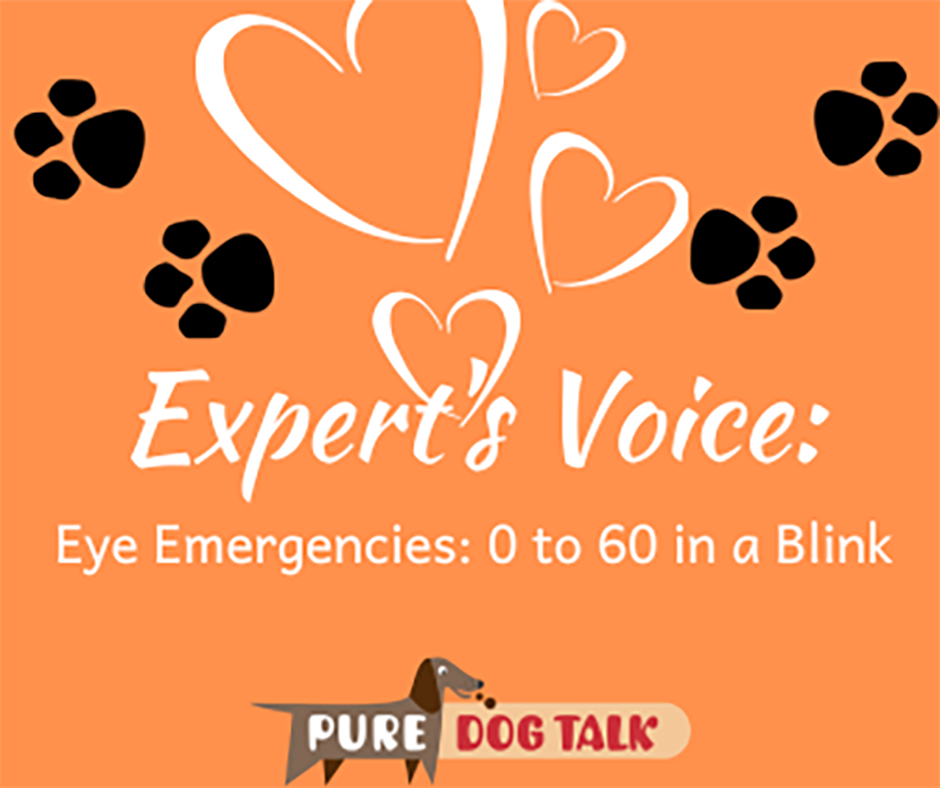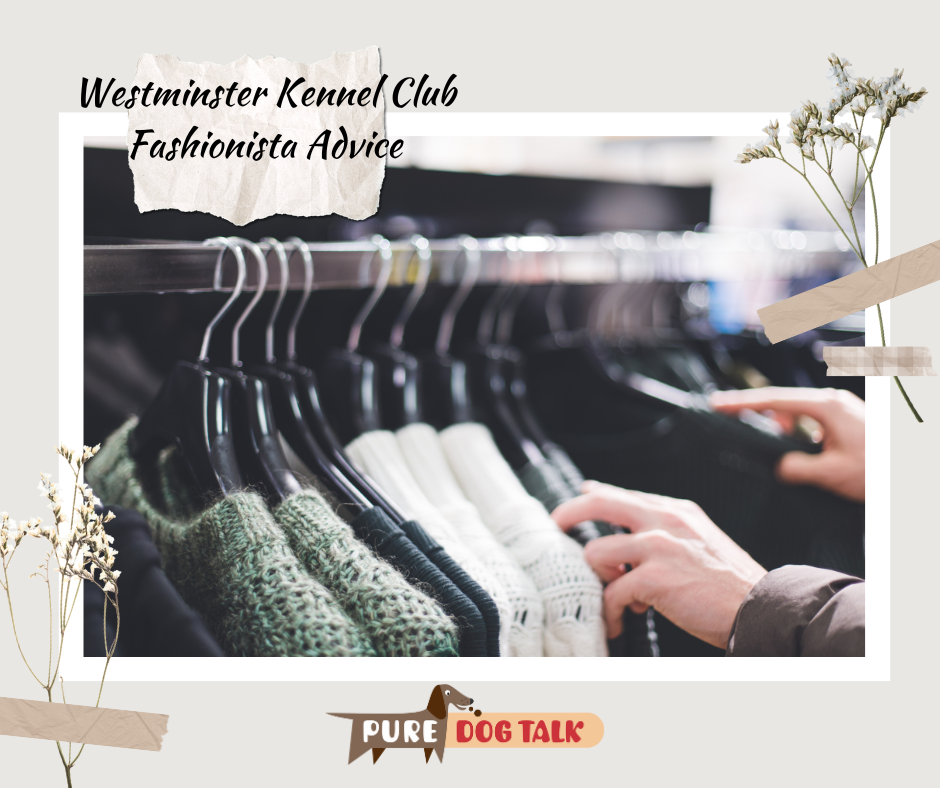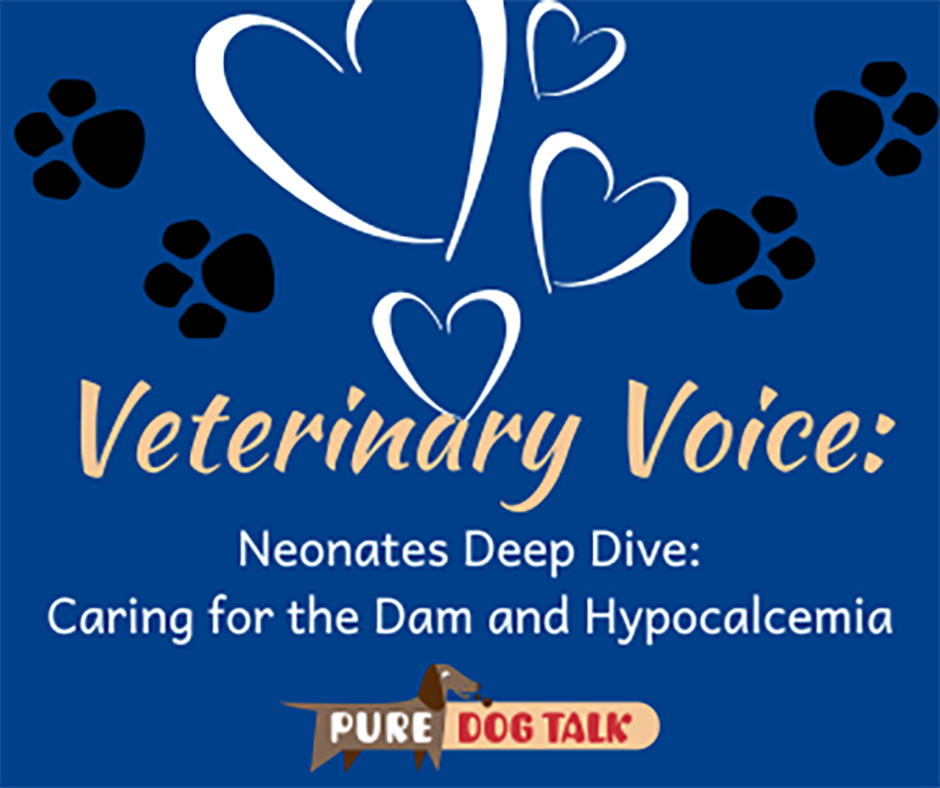Posts by Laura Reeves
637 – What Your Puppies’ Poopy Tells You
What Your Puppies’ Poopy Tells You
Dr. Marty Greer, DVM joins host Laura Reeves for an extended conversation about puppy poopy. Color, consistency, contents and coating of the puppy’s stool give detailed information about its gut health. They also discuss prevention and treatment of common intestinal upset.
“A yellow, softened, seedy stool is absolutely normal (for the first two weeks),” Greer said. “It’s not that they’ve eaten anything that shouldn’t be in there. That’s just normal milk curd being digested and the normal color with the digestive enzymes.”
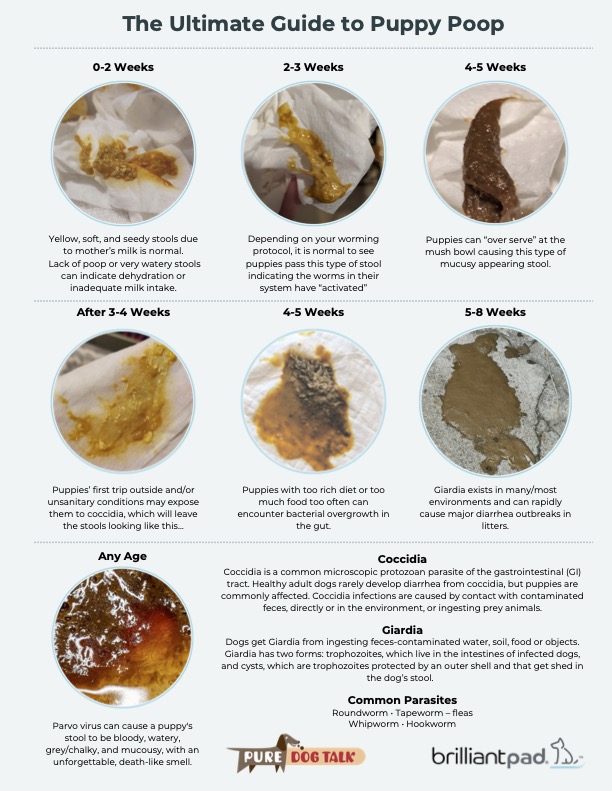
Puppy stool samples and what they tell you, at a glance.
To watch the entire presentation, with photos, click the link HERE.
Intestinal parasites
“If a bitch ever had roundworms when she was a puppy or ever had hookworms when she was a puppy, those will encyst in her muscles and they will reactivate during the stress of pregnancy and lactation and migrate,” Greer said.
“Roundworms migrate through the placenta into the puppies. So, this is how puppies are born with intestinal parasites, is they’re already born with them before they are hatched, they come out, and hookworms will migrate through the milk and into the puppies.
“So this is how we end up with parasites that are going to cause problems in puppies. And they typically will start to become an issue when the puppies are right about three weeks of age. So just three to four weeks, just about the time you’re starting to wean, about the time you’re trying to get them on to solid food, they get sick, they feel puny, they have a belly ache, they don’t feel good, you end up going to the vet.
“Sometimes those stool samples are negative even if the parasites are there because the parasites need to be at least three weeks old to produce the eggs that it takes for them to see under the microscope.”
Worming pregnant dams with Fenbendazole (Pancur) is the only guaranteed way to raised puppies not born with intestinal parasites.
“So Panacur, you start at day 42 of the pregnancy,” Greer said. “And you give the dewormer every single day from day 42 of the pregnancy until the puppies are 14 days old. That is five weeks. The label says three days, and I understand the label says three days, but it is a five -week protocol. It is an off -label use, technically, but I can say that because I’m a veterinarian and I’m allowed to say those things. This protocol was published for the first time in the early 1980s.
“We’re giving 50 milligrams per kilogram once a day (to the dam for five weeks). If you give the suspension, not the tube paste, but the suspension, the liquid stuff that you shake up. That’s given at one cc per four pounds of body weight. Safeguard, Panacur, fenbendazole is all the same thing. So if it’s a 10 % solution, it’s one cc per four pounds of body weight. Or you can use the granules. Now granules come in little packages, but they also come in a one pound tub, so there are very cost effective ways for you to get this. I’ll tell you the bitches don’t like the medication given daily, but you know what? I don’t like worms in my washing machine and in my puppies, so I’m going with, I’d rather deworm the bitch.”
636 – Study Shows Purebred Dogs Healthier Overall than Mixed Breeds
Study Shows Purebred Dogs Healthier Overall than Mixed Breeds
Dr. Kiersten Forsyth, DVM cardiology resident at Purdue and lead author of the recent paper from the Dog Aging Project discussing findings on health in our canine companions, joins host Laura Reeves with the details, which are not necessarily the same as what you might have heard.
“The Dog Aging Project is this really cool community science project,” Forsyth said. “Essentially, there are some researchers that are involved at a few different universities, but the main people that are involved in this project are the dog owners themselves. People can nominate their dog to participate.
“It is a longitudinal observational study, which basically means as a pet owner, once a year you fill out this really big survey that tells all about your dog, what their history is as far as their health, but also where they live, what kinds of things they do, the environment they’re in. And that information for one dog might not tell us a lot, but when we have tens of thousands of dogs participating, we can pull a lot of information from this.
“And so once a year, you get to refill out this survey, and we can follow these dogs throughout their lifetime to see what changes, what they’re exposed to and our real goal is to learn more about all of these dogs in the U.S., but also what makes some dogs live longer than other dogs and can we get more information about aging in these dogs?
“For the specific research part that I was involved in, we were looking at all of the dogs who were enrolled in the study during the year of 2020. We had 27,541 dogs included. So, a huge number.
“Of those, about 50 percent of them were mixed breed dogs and 50 percent of them were purebred dogs. We tried to look at what the 25 most common or popular dog breeds were that made up the dog aging project pack at that point in time and then really focused on those top 25 breeds to then say, ‘okay for these specific breeds, what are the most common medical conditions that their owners are reporting their dog to have experienced in their lifetime’.
“So, for each breed, we came up with a list of their 10 most commonly reported conditions, and then we looked to compare how those changed between different breeds and between the mixed breed population and the purebred population to see is there really a difference in the amount of medical conditions that a dog gets if they’re a purebred dog versus being a mixed breed dog.
“When we looked at it, one of the things we were wondering was, do purebred dogs have more disease than mixed breed dogs? And we found, no, that’s not the case. In fact, it might even be slightly suggested into the opposite, ’cause we looked at, of all of these dogs, how many of them did not have any health conditions reported?
“These are our healthy dogs. Nothing has been reported to be wrong with them. And we found that 22 percent of the purebred dogs had no reported medical conditions. And just under 21 percent of the mixed breed dogs had no medical conditions. So, there was really a 1.6 percent difference between the two of them, which is not a huge difference, but it was actually statistically significant that the purebred dogs were actually more likely to have no owner-reported medical conditions than our mixed breed dogs.
“It’s really not more likely to have disease in your purebred dogs.
“Now, specific breeds may be more likely to have specific conditions. And that goes along with, you know, I do a lot of stuff with the heart. I know that if we think of degenerative valve disease, Cavaliers come to the top of your mind, or if you think of dilated cardiomyopathy, Dobermans come to the top of your mind. And we’re not saying that certain breeds aren’t more prone to very specific diseases or medical conditions, but as a whole, being purebred doesn’t show a higher reporting of medical conditions compared to mixed breed.
“It’s turning out that common things happened commonly, where even though we’re looking at these purebred dogs, where you might think they’re prone to very specific diseases or medical conditions, it still is things like dental disease, dog bites from other dogs. Those are still some of the things that are showing up frequently across breeds, not just with one specific breed.”
635 – NOHS Regional Events from the Club’s Perspective
NOHS Regional Events from the Club’s Perspective
Ryan Horvath and Sandra Pretari Hickson join host Laura Reeves to discuss the upcoming first ever NOHS Regional Event at their Harvest Moon Classic dog shows Oct. 17-20 this year.
“Since the inception of the owner handled competition, we’ve included it in our shows every year,” Horvath said. “And we’ve also recognized the need to elevate it to a status on par with the rest of the show. So, we’ve offered similar trophies. We have the event taking place right in the main hall with the rest of the show so that you can kind of go pick and choose what you want to watch, who you want to cheer for, you know, and make sure that you can make all your ring times because, you know, it can get a little hairy sometimes.”
“(NOHS Regional) is happening on Saturday,” Pretari Hickson said, “on the same day as the regular dog show, but it is a standalone event. So we’re not offering the traditional owner handled that day.
And we have rings dedicated to just owner handlers. And we actually have brought in judges just for this.”
“It’s challenging being one of the first clubs to put this on,” Horvath added. “Trying to invent it from the ground up. And we are in a new site that we’ve had two years in and we continue to evolve and develop new things that we need to improve each year. So this is one more thing that we have to integrate in and kind of start out without anyone to look at and see how they do it.
“One of the things that we try to pay attention to, and something we’ve definitely done for this regional event, is to have judges that are approved for these groups. And so you’re gonna have judges who, judge them, know the breeds, and many times we’ve had them on our panels doing similar breeds and groups in the past. So, we’re thrilled to be able to provide them with an equal stake.”
634 – Best Advice from Best in Show Judge, Roz Kramer
Best Advice from Best in Show Judge, Roz Kramer
Roz Kramer, Best in Show judge for Westminster Kennel Club last week, joins host Laura Reeves with advice, stories, suggestions and tips for all exhibitors.
On judging Best in Show at Westminster
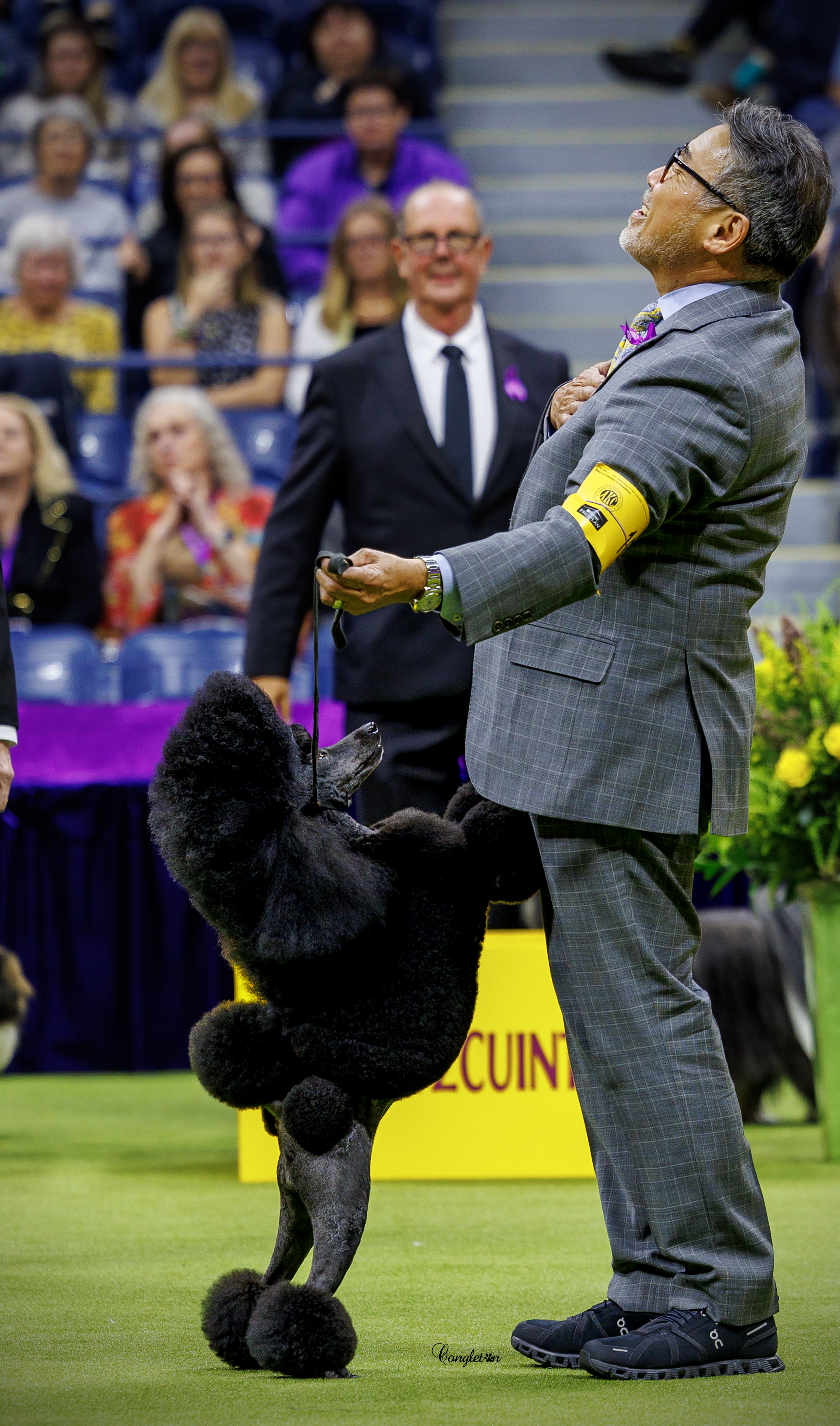
Kaz Hosaka, winning BIS at WKC with the Miniature Poodle, Sage.
“You know, you’re sequestered and so you don’t really know who you’re getting and they come in the ring one at a time and it was one gorgeous dog after another.
“I mean, all of them showed like a million bucks. They all looked wonderful, fabulous condition. And it gave me goosebumps. It really did. I was so happy and so thrilled.
On her mentors
“I have had three incredible mentors for me Annie (Rogers Clark), Janey and Bob (Forsyth). I had so much respect for the three of them. Annie, she was such a teacher in many ways. I never worked for any of them, but you saw them at shows all the time and they’d give you little hints or little suggestions all the time and or you’d just sit and listen to them and you’d learn.
On how newer exhibitors can succeed
“You should stick around (after showing in the ring), learn your history of your breed, learn who the greats of the breed were, learn your pedigrees, figure out who the best multiple breeders of your breed, and it wouldn’t matter if they’re ones on the west coast and ones in Texas and ones in Maine. Seek those people out, learn the best you can. And then if you get a dog, don’t be afraid to go, not just ask other breeders for help on trimming or showing.
“I’m telling you, you go to most of these handlers, it doesn’t matter who they are, they are more than willing to help. We need the new people in the sport and everybody knows it and I think that what people also need to do is don’t think that you’re better than everybody else, be kind and caring to people because you know something, we all have to ask for help at some point in our lives and don’t be afraid to.
“You know one of the ways that I learned when I was a kid is my mentor on the Scotty’s John Sheehan. He’d trim the show side and then he’d say ‘okay now you trim the other side. Copy that.’
“(There) is the conditioning part. And it was a teaching tool to me that you do this day after day, hour after hour, and don’t stop. And it’s going to pay off.
“It’s artistry, and I think people prefer the quick fix and the easy fix. I think that people should give themselves a challenge, prove what they can accomplish and they might be surprised.”
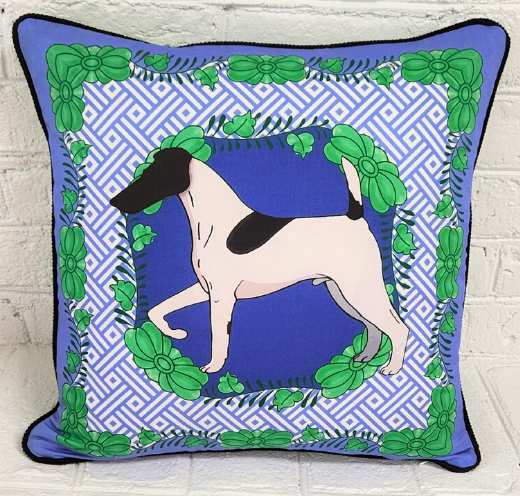
Kramer’s Etsy shop features home decor and fashion items like this pillow cover.
Visit Kramer’s Etsy shop to see her beautiful breed specific designs on home decor and fashion items.
633 – The New Voice of Westminster Kennel Club
The New Voice of Westminster Kennel Club
Host Laura Reeves is joined by Valerie Nunes-Atkinson, handler, breeder and the new color commentator at Westminster Kennel Club.
“So I think one of the reasons why I’ve been brought in is because of some of the things that you mentioned, being a handler, having lived it and been there. So I’m hoping to bring the insight from that perspective, from the handler’s perspective, the excitement of it, what goes on a little bit behind the scenes, but then also from a breeder perspective, you know, having bred dogs that have done well there and bred dogs for decades.
“Jason has been a breeder and a handler and a judge, but he’s more from the judge’s perspective and the historical importance of the breeds and details of the breeds. And I hope to bring a little bit of the other type of knowledge. And Chris is our fun guy that asks interesting questions.
“You learn how to listen to someone in your ears and still talk… It’s something, I will say it’s something to get used to. So they’re talking in your ear. ear and they’re counting you down. So literally we have about 20 seconds after the announcer gives all the breed details on that particular breed to make a point about something and keep it somewhat interesting.
“Twenty seconds is a long time, but it’s really not a long time. So to be concise and get your message across and be done before he starts going into the next breed. So they’re counting you down as you’re talking and trying to make your point in these 20 seconds and you have to be done by the time they get to one. Otherwise, someone might be screaming in your ear.
“So learning that and learning how to go back and forth between the three of us and not step on each other, so that you’re not talking over the other person.
“There’s a huge learning curve and we’ll see because, you know, it basically scares the, you know, what out of me to be doing this. And I really considered not doing it. But my dad always told me, and this was before he passed, he said, ‘If you’re not doing something that is scary and challenges you and really scares you, you’re not growing.’ So you’ve got to live your life. You’ve got to push yourself and reach for other goals. And so I’m doing it.
“And that’s where I think, you know, through this broadcast and through Jason and Chris, I mean, we hope to, you know, give breed details. We hope to give breed information to the general public. That’ll be interesting that maybe allows them to think about other breeds and hopefully maybe even learn how to find a preservation breeder.
“I think being able to, for my role, step in and maybe tell some little tidbits of stories or experiences that I’ve had that might bring other people in to say, ‘Hey, maybe I could try that or that sounds fun.’ Or maybe they don’t even know about things we’re talking about like the agility. trial that’s gonna be there as well. There’s other sports within AKC that the general public can do wth their dogs, which is very exciting. And I think it’s a way to bring everybody else, the general public into a scene, what else you can do with your dogs?”
632 – Expert Tips for Expanding Puppies’ Minds
Expert Tips for Expanding Puppies’ Minds
Dr. Marty Greer, DVM joins host Laura Reeves for their ongoing conversation about raising puppies. This month they’re talking week four, when the puppies’ minds are exploding with new sensory input.
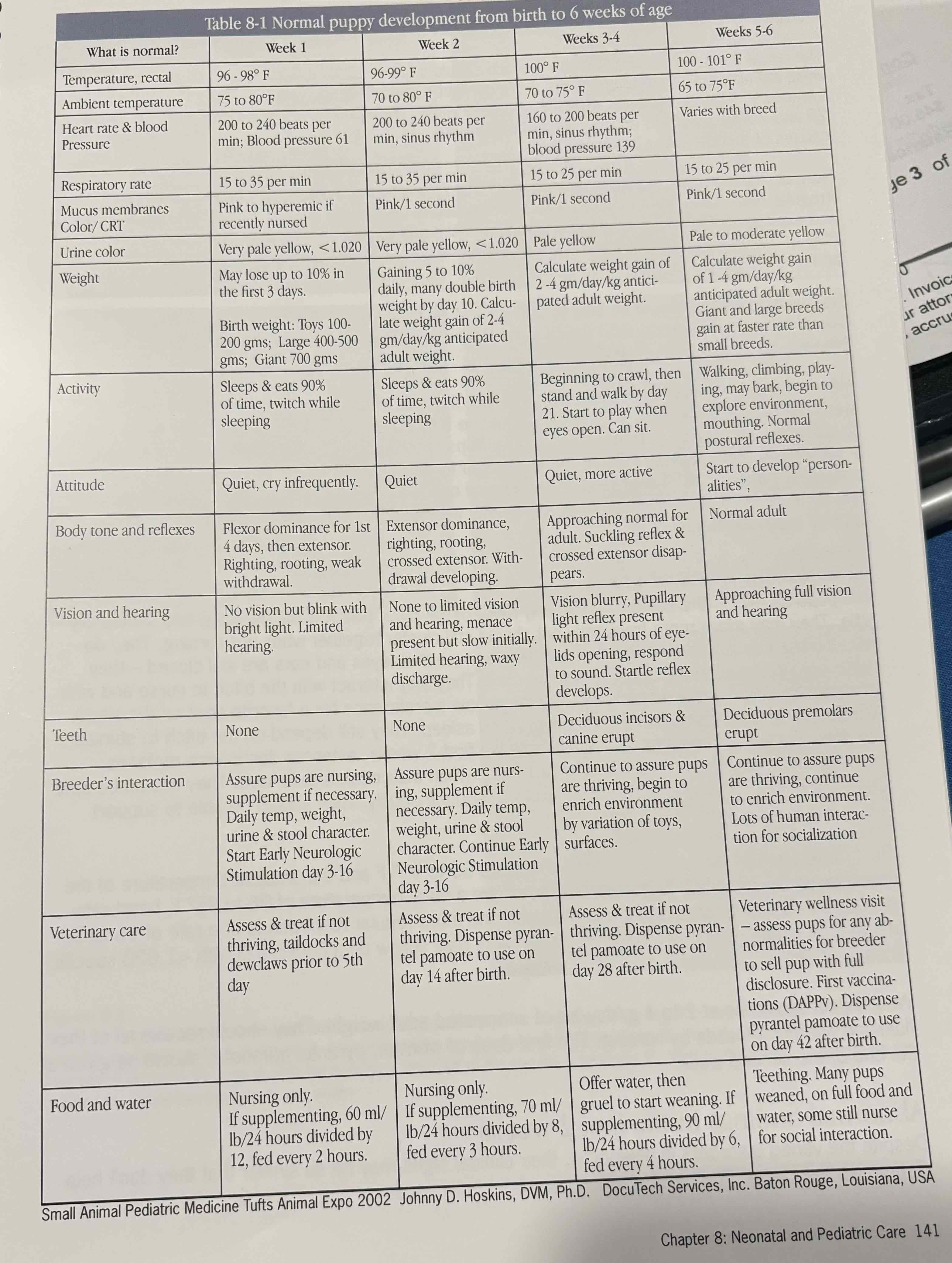
From Dr. Greer’s “Canine Reproduction and Neonatology”
“When the puppies first open their eyes, first open their ears, we should have gentle lighting, we should have gentle sounds,” Greer said. “We shouldn’t just have this loud TV with Rambo on. So, you know, things like just have the lights starting to come up, their vision isn’t great, their hearing isn’t great, but it went from almost nothing to something and so we want to ease them into that world.”
Four weeks is when many puppies are introduced to solid food. Mothers of wild canids vomit for their puppies as their introduction to solid food. Laura describes making puppy food the “consistency of dog vomit.”
Marty recommends shallow water bowls for puppies to prevent drowning hazards, as well as Lixit bottles for smaller breeds.
100 experiences in 100 days
“I try to do a lot of variation in the enclosure. I have a rabbit hutch that’s got a two story ramp on it so they can go in and out of doors and up and down the ramp. I have all kinds of little beds that have holes and places for them to go. Honestly the best toys are the kids’ toys that I pick up at garage sales. So you pick up, you know, baby walkers and all kinds of toys and they’re brightly colored and they’re hard plastic. They’re not durable enough for the aggressive chewer or adult dog. So you probably don’t want them in with mom if you’ve got a lab that eats everything, but they’re fun. They make interesting noise and you can do variability.
“I think both Sophia Yen and Ian Dunbar, veterinarians that talk a lot about behavior and development, talk about a hundred experiences in a hundred days.
“I have a series of 11 bath mats that are all different sizes, shapes, colors, textures. The mesh ones I put under the puppies when they’re really young because the urine runs through and so they stay dry. When you’re in that transition period between when mom stops cleaning them, that two to four week transition period when they start urinating on their own, they stay dry and it doesn’t soak into a pad directly on their skin so it’s cleaner and neater.
“And those again can go in the washing machine. But I went to Walmart during COVID and they had 11 styles of bath mats. They had some with bristles, they had some that were shiny, some with round holes, some with square holes, some were dark colored, some were light colored. Just this whole variety and again I throw them in my washing machine when they get soiled and then I hang them to dry. And I have two sets so that they can rotate through. And you’ve just given now a puppy 11 different surfaces, so of the 100 experiences you need to do in 100 days, you just did 10 percent of them, with a bath mat.”
631– Eye Emergencies Can Go From 0 to 60 in a Blink
Eye Emergencies Can Go From 0 to 60 in a Blink
Host Laura Reeves is joined by veterinary ophthalmologist Stacey Halse for a deep dive on eye emergencies in our dogs.

Dr. Stacey Halse, veterinary ophthalmologist, with one of her Dobermans.
“Eyes are a very unique structure when it comes to every other organ, well, most other organs in the (dog’s) body,” Halse said. “They have what you call the fancy word for is a blood aqueous barrier. It kind of protects the inside of the eye from the rest of the immune system. The eye itself is called an immunoprivileged site. And so when things go wrong and the regular immune system kind of gets into the eye, it can go very wrong very quickly.
“And so emergencies can go from, oh, it’s just a little scratch, just… to suddenly you’re like, “Oh, now the eyeball’s melting out of the face.” And so that’s always very scary, both for an owner and a dog.”
Eye Infections in Newborns
“One of the biggest things that you can do is get that eyelid open even though the eyes are only supposed to open at about two weeks old, you don’t want that material to stay in there. And so if it’s not draining yet, warm compressing and just gently massaging those eyes open to get that material draining because if it stays in there, it’s going to ruin the eye. It’s going to cause scar tissue that can affect the puppy for the rest of its life. And I haven’t seen it a ton, but in the worst case. case scenarios, usually the shelter dogs that are kind of not brought in to care, but they can lose their eye. And so outside of medications, just getting that eye open is really the most important part.”
Steroid Cautions
Generally, any ulceration or scratch of the eye’s surface should NOT be treated with steroids.
“If there’s an ulcer there and you don’t know because you don’t have the staining and all this stuff, you just wanna be cautious and kind of just do the topical antibiotics. In general, something like neopolybac, which a lot of people have, or a topical drop, most often if I’m prescribing it, I’ll use Tobromycin because you only need something that’s superficial. But I feel like a lot of the time people have neopolybac in the dog world.
“You just have to make sure there’s no steroid in it. So the two steroids that can be a neopolybac is hydrocortisone or dexamethasone. Dexamethasone probably the most common, but hydrocortisone is the one that’s most commonly missed because people are just looking for dexamethasone on the thing. And one little trick that I teach students as well as owners is that if there’s a pink strip on the box, it’s a steroid. Tan is antibiotic, pink is steroid.
Corneal Ulcers
“The cornea is only about 0.8 millimeters thick, so it’s super, super thin. And so an infection anywhere else, not a huge deal. An infection on the surface of the eye can be very bad very quickly. You can lose the eye within 24 hours. I’ve had one in the hospital that I was medicating aggressively and then we still lost the battle. And it like developed an ulcer in the hospital. This was like during my residency and we started treating right away and we still lost it.
“I don’t wanna freak everyone out but that’s the worst case scenario. – If there’s a little bit of squinting, and if you ever see a divot on your dog’s eye, just take it in.”
630 — Westminster Kennel Club Fashionista Advice
Westminster Kennel Club Fashionista Advice
Host Laura Reeves is joined by Veronica Wolfe of Best In Show Clothes, talking about that *perfect* WKC outfit, hair, nails, makeup and more.
“So, you know Westminster, it is the premier dog sport event of the year,” Wolfe noted. “It is the second oldest sporting event in the nation only behind the Kentucky Derby and then only by two years. It’s been going on since 1877. So you have to give some respect to the event. Very prestigious, limited number of dogs, the juniors invitation only.
“There’s a few factors you need to consider. One is the event, of course. You know, and how do you get ready and how do you dress for Westminster? My first thought would be the way you get ready and appropriate for really any dog show. You’re representing your breed. If you have a kennel, you’re representing your kennel. If you’re a handler, you’re representing your client’s dogs. If you’re an assistant, you’re representing your handler,
“So everybody should look professional, okay? So you need to have professional clothing and you need to have all the support factors that we talked about in our first podcast. You’re going to be on national television by all the possibilities. If you’re not on national television, then I’m sure your breed’s going to be on YouTube, right? Yes. So have those good shoes on. Have the good support wear on. Don’t skip the pantyhose on this one, that kind of thing.
“But you also need to consider the weather. You need to consider the location. Everything’s not indoors anymore. So let’s run down a couple of those things.
“The temperatures in May and New York are gonna be 71 high day, 54 low. That’s average. So if you’ve got an eight a.m. ring time and now they’re outdoors, right? You need to consider that. You need to dress appropriately for that eight a.m. ring time. If you’ve got to change later on because woohoo, you made it to groups, then you can plan for that. But consider the weather.
“It can be humid and it can be hot in May also so you’ll want to consider that when you’re debating between the Tahari suit versus the wool blend St. John. It can also be wet. The average rainfall in that area in May is 3.9 inches to give you an idea. In eastern Washington, that’s like a quarter of our rainfall for the year. So prepare for that. Bring a raincoat. You don’t want to, you know, have that beautiful suit or a silk blend suit, get water on it. So the weather you need to consider, the time of day, once the schedule comes out, you need to consider for what you’re wearing.
“And then you’ve got groups and the finals for juniors, moves indoors. I would say be mindful that that indoor carpet is green. You might want to consider what you’re wearing with that. I’d be careful of wearing a similar green. – One giant green blob. With that color, a lot of people love to wear purple to Westminster ’cause Westminster’s purple and gold. But then a lot of people are wearing purple. So you need to be aware of that.
“I think blue and green always go really well together. Depending on your dog if you’re of the mindset that you prefer to really stay in the background, grays, blacks and tans can go nicely with that color carpet. Certain red tones if you do the blue based reds and not the orange based reds, I think the blue based reds almost leaning towards burgundy would be okay with that.
“You want to present a very professional image without distracting from the dog and that the dog should be the center of attention. If you love bling and you want to wear it great. There is a love of bling in the dog show world and I sell a lot of bling online and in my booth. If you’re not careful, I think it can be distracting.
“And juniors, can I address you a minute? Because I have a junior. You know, you or your parents do not need to go out and buy a six hundred to a thousand dollar suit for this show There are gorgeous Taharai, Le Suit, Casper. All those. You can get beautiful suits that accentuate your dog that aren’t St. John and if you just have to have a St. John, make sure that it’s age appropriate and it doesn’t look like a St. John that should be on somebody maybe more my age.
“You want to look your age. If you’re young, you want to look young, professional, neat, clean, your hair back out of your face. Yeah, it’s prestigious, but you don’t have to wear or own or buy a St. John. Of course, I’d love to sell you one, but you know, it’s not necessary.”
629 – Neonates Deep Dive: Caring for the Dam and Hypocalcemia
Neonates Deep Dive: Caring for the Dam and Hypocalcemia
Dr. Marty Greer, DVM joins host Laura Reeves for a continuation of their ongoing conversation about neonates. The discussion today includes hypocalcemia and eclampsia, how much calcium to supplement and when.
“For some bitches, you need to continue (calcium supplementation) until the puppies are weaned,” Greer said. “It depends on the size of the bitch and the size of the litter. The smaller the bitch and the bigger the litter, the more you need calcium. It tends to be… in small breed bitches that develop hypocalcemia, eclampsia, that that tends to be an issue.
“We don’t see it in Labs, Goldens, Rottweilers, you know, the big dogs, but in the little dogs, and you know, I mean little dogs usually under 10 or 15 pounds, dachshunds, terriers, some of those small breeds, we can see hypocalcemia. In those cases the bitch will start to run a low grade fever. The first symptoms are going to be that she starts walking kind of goose-stepping like real stiffly, associated with the calcium becoming too low and then her muscles developing this tetany.
“When the puppies are growing at about that two to three week time period, when the puppies are really growing fast, is when the demands of the calcium become the greatest on those small breed bitches and they just don’t have the ability to mobilize enough calcium from their bones, their vitamin D levels are trying, but they just don’t have the ability to mobilize calcium quickly enough.
“And this is why you don’t want to give calcium prior to the time that the bitch goes into labor and has her puppies. If you give it during the entire pregnancy, then you tell her parathyroid gland, “You know what, you can just take a vacation. “You don’t have to worry about this, just hang out.” And then their calcium doesn’t mobilize adequately.
“So you want them on a normal amount of calcium in their regular dog food, and then once they whelp, then that’s when you can start adding the additional calcium in gel form, in tablet form, in powder form to the diet along with the puppy food to make sure she gets adequate amounts of calcium.
“The powder, the gel, those are all going to be fine and safe because the GI tract is going to only absorb and the body’s only going to take in so much. So you’re okay to be pretty aggressive. Now there’s definitely some things that you have to be concerned about if you’re giving (calcium) by injection. But if you’re giving oral in the powder or the tablet form, you know the petcal or the revival or the whatever product you want to use, those are all absolutely fine to give. You have to really screw up to give too much. But it does make a big difference and you basically titrate it until you see the effect that you’re looking for.
Greer touches on a variety of different topics in this wide-ranging conversation, so check out the entire podcast here.
628 – Show Safe Launches for the Dog Sport Community
Show Safe Launches for the Dog Sport Community
Host Laura Reeves is joined by Mary Dukes, Lindsay Fetters and Carissa Shimpeno to discuss their new grassroots launch of Show Safe. The organization encourages all exhibitors to take the Safe Sport program and offers a lapel pin to those who complete it.
“I knew about Safe Sport through my daughter, who’s a professional horse trainer,” Dukes said. “And safe sport is a congressionally mandated program for all Olympic sports that came in after the multitude of abuses in gymnastics, swimming, diving, I could go on. So anyway, I was familiar with it because my daughter shows horses and since equestrian events are an Olympic sport, she has to take safe sport and a re -up every year. I got it in for the registered handlers program and then I always had wanted to expand it. I advocated to expand it to at the very least junior judges, but while I was an employed by the AKC I was never able to get that done.
“Everybody has a story. Everybody has a story to varying degrees. I feel like mine is relatively minor in the big scheme of things, but everybody has a story of being inappropriately touched, inappropriately propositioned, all that.”
“Historically when something happens people react and everybody wants to do something,” Fetters said. “But I feel like a lot of people put it off on somebody else. ‘The government needs to do this, the AKC needs to do this’… It’s like we’re upset about something, but we’re saying it needs to be somebody else’s mission.
“I sort of was reflecting on what can we do, what can I do, what can you do, what can we do as a fancy because I think if anybody can be united over something it’s united over protecting our children.
“I don’t know a single person who would disagree with the mission of let’s do better for our next generation but it’s hard to invoke change. It’s hard to start a movement, it’s hard to unite people as just one solo person, especially in our sport.
“My idea was basically, let’s do a grassroots movement. Let’s control what we can control. And let’s let people know that this training and this option is out there. And instead of mandating or instead of controlling somebody or demanding somebody do it, because I think that that immediately puts somebody on edge, like let’s say, ‘okay, look, this options out here, let’s pursue it. And if you do, we want to let other people know we want to let juniors know. We want to let other people in our sport know that we’ve had this training and we’re here to be a listening ear and we’re here to provide support.”
“I guess I would have to say my biggest learning experience in what works and what doesn’t work started last year,” said Shimpeno. “When we had a handler who had been to prison for raping his minor assistant and he was returning to the world of dogs. In my mind I thought well what a beautiful way to show the young people of our sport that we actually have their back. Why don’t we try and make some kind of policy within AKC that says, you know, if you’ve been convicted of X, Y and Z, that we can’t stop you from coming to the dog shows, we can’t stop you from existing and we can’t make you a better person. But we can send a message to our little people and men and women around the sport in general just saying this is not what we’re about. We’re going to take a stand and we’re going to draw a line in the sand.
“A year ago, Mary actually said, you know, why don’t we stop asking AKC to do this? And we do something ourselves. And my response in that moment was like, ‘because that’s not right.’ We have to be the better people, like we have to make them do what’s right. That mindset got me exactly nowhere at all.
“We have this large portion of people out there that are just stuck in the injustice of it. And I want them to understand that we get that and we don’t want to minimize the pain, the trauma or anything they’ve been through. But our group of people has learned through experience that we need everybody to receive this message.
“And in order for that to happen, we have to be way more organized. and focused. We are not a vigilante team. This has nothing to do with the perpetrators themselves. It’s not even about necessarily protecting. It’s about empowering, right, like knowledge through education.”


